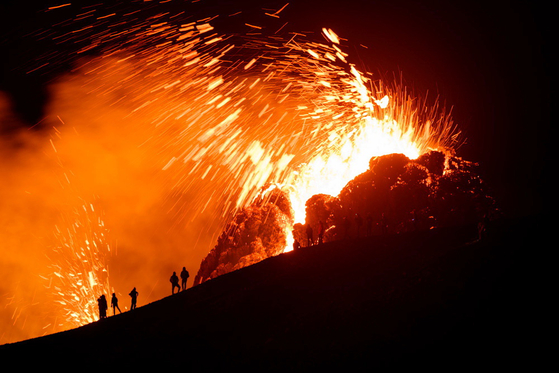In Iceland, Northern Europe, a volcano has been erupting from the 19th (local time).

A volcanic eruption on the Reykjanes Peninsula in the southwestern part of Iceland’s capital city on the 19th has caused lava to flow down at night on the 20th (local time). Reuters = Yonhap News
The volcano erupted this time in the Pagradalspiad area of the Reykjanes Peninsula, about 40 km southwest of the capital Reykjavik. Four hours after the explosion, the surrounding 1km2 area was covered with lava, and aircraft operations at nearby international airports were temporarily suspended, creating confusion. It is the first time since 1240, 800 years ago, that a volcano erupted on the Reykjanes Peninsula.
In Iceland, more than 40,000 large and small earthquakes occurred in the last month, predicting the possibility of a volcanic eruption. In particular, on the 27th of last month and the 1st of this month, an earthquake of magnitude 5.0 or more occurred. Iceland, where more than 100 volcanoes are distributed, is located between the Eurasian Plate and the North American Plate, so volcanic activity is active.

Lava is flowing down from a volcano on the Reykjanes Peninsula. Reuters = Yonhap News

On Sunday, the 21st (local time), Icelanders visit the site of a volcanic eruption on the Reykjanes Peninsula to observe volcanic activity. Volcanoes in this area began to be active after 800 years. AFP=Yonhap News

On the 21st, a volcano on the Reykjanes Peninsula is erupting lava. Reuters = Yonhap News

Lava erupted from the volcano covers the area around the 21st. AFP=Yonhap News

The volcanic eruption site as of the 20th. Reuters = Yonhap News

The red lava from the volcano is cooling down. AP=Yonhap News

The scene of a volcanic eruption on the Reykjanes Peninsula taken aerial photography on the 20th. AP=Yonhap News

Pagradalspiadul volcano seen from Grindavik, 40 km west of Iceland’s capital, Reykjavik. The red lava is faintly visible. AFP=Yonhap News
In April 2010, a volcanic eruption occurred in Eyaf Yalayökull, south of Iceland, stopping aircraft operations in neighboring countries. Air riots broke out as aircraft operations at Keflavik International Airport in Reykjavik, Iceland, as well as major airports in Northern Europe such as the UK, Norway, Sweden, Finland, and Denmark, were banned for a month. Small pieces of rock, glass, and sand contained in volcanic ash are dangerous enough to stop aircraft engines.
Fortunately, the volcanic eruption of Pagradalspiadul has little effect on aircraft operation, unlike the Ayaph Yalayokul volcano. The surrounding airports are now operating normally, and the volcano, which has been active after sleeping for many years, is attracting people to see the mystery of the Earth.
Reporter Choi Jeong-dong
![]()
